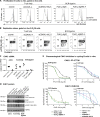CHK1 dosage in germinal center B cells controls humoral immunity
- PMID: 30894677
- PMCID: PMC7224292
- DOI: 10.1038/s41418-019-0318-5
CHK1 dosage in germinal center B cells controls humoral immunity
Abstract
Germinal center (GC) B cells are among the fastest replicating cells in our body, dividing every 4-8 h. DNA replication errors are intrinsically toxic to cells. How GC B cells exert control over the DNA damage response while introducing mutations in their antibody genes is poorly understood. Here, we show that the DNA damage response regulator Checkpoint kinase 1 (CHK1) is essential for GC B cell survival. Remarkably, effective antibody-mediated immunity relies on optimal CHK1 dosage. Chemical CHK1 inhibition or loss of one Chk1 allele impairs the survival of class-switched cells and curbs the amplitude of antibody production. Mechanistically, active B cell receptor signaling wires the outcome of CHK1-inhibition towards BIM-dependent apoptosis, whereas T cell help favors temporary cell cycle arrest. Our results predict that therapeutic CHK1 inhibition in cancer patients may prove potent in killing B cell lymphoma and leukemia cells addicted to B cell receptor signaling, but will most likely dampen humoral immunity.
Conflict of interest statement
The authors declare that they have no conflict of interest.
Figures







Similar articles
-
Checkpoint kinase 1 is essential for normal B cell development and lymphomagenesis.Nat Commun. 2017 Nov 22;8(1):1697. doi: 10.1038/s41467-017-01850-4. Nat Commun. 2017. PMID: 29167438 Free PMC article.
-
SYK Inhibition Induces Apoptosis in Germinal Center-Like B Cells by Modulating the Antiapoptotic Protein Myeloid Cell Leukemia-1, Affecting B-Cell Activation and Antibody Production.Front Immunol. 2018 Apr 24;9:787. doi: 10.3389/fimmu.2018.00787. eCollection 2018. Front Immunol. 2018. PMID: 29740433 Free PMC article.
-
Apurinic/apyrimidinic endonuclease 2 regulates the expansion of germinal centers by protecting against activation-induced cytidine deaminase-independent DNA damage in B cells.J Immunol. 2014 Jul 15;193(2):931-9. doi: 10.4049/jimmunol.1400002. Epub 2014 Jun 16. J Immunol. 2014. PMID: 24935922 Free PMC article.
-
T cell interactions with B cells during germinal center formation, a three-step model.Immunol Rev. 2019 Mar;288(1):37-48. doi: 10.1111/imr.12737. Immunol Rev. 2019. PMID: 30874355 Review.
-
Plasma cell differentiation during the germinal center reaction.Immunol Rev. 2019 Mar;288(1):64-74. doi: 10.1111/imr.12751. Immunol Rev. 2019. PMID: 30874351 Review.
Cited by
-
ATR-mediated DNA damage responses underlie aberrant B cell activity in systemic lupus erythematosus.Sci Adv. 2022 Oct 28;8(43):eabo5840. doi: 10.1126/sciadv.abo5840. Epub 2022 Oct 28. Sci Adv. 2022. PMID: 36306362 Free PMC article.
-
SETD2 Haploinsufficiency Enhances Germinal Center-Associated AICDA Somatic Hypermutation to Drive B-cell Lymphomagenesis.Cancer Discov. 2022 Jul 6;12(7):1782-1803. doi: 10.1158/2159-8290.CD-21-1514. Cancer Discov. 2022. PMID: 35443279 Free PMC article.
-
Illuminating (HTLV-1)-induced adult T-cell leukemia/lymphoma transcriptomic signature: A systems virology approach.Virus Res. 2023 Dec;338:199237. doi: 10.1016/j.virusres.2023.199237. Epub 2023 Oct 23. Virus Res. 2023. PMID: 37832654 Free PMC article.
-
PIDDosome-induced p53-dependent ploidy restriction facilitates hepatocarcinogenesis.EMBO Rep. 2020 Dec 3;21(12):e50893. doi: 10.15252/embr.202050893. Epub 2020 Nov 23. EMBO Rep. 2020. PMID: 33225610 Free PMC article.
-
Inferring tumor-specific cancer dependencies through integrating ex vivo drug response assays and drug-protein profiling.PLoS Comput Biol. 2022 Aug 22;18(8):e1010438. doi: 10.1371/journal.pcbi.1010438. eCollection 2022 Aug. PLoS Comput Biol. 2022. PMID: 35994503 Free PMC article.
References
-
- Shlomchik MJ, Weisel F. Germinal center selection and the development of memory B and plasma cells. Immunol Rev. 2012;247:52–63. - PubMed
MeSH terms
Substances
Grants and funding
- I 1298/Austrian Science Fund (Fonds zur Förderung der Wissenschaftlichen Forschung)
- P 26856/Austrian Science Fund (Fonds zur Förderung der Wissenschaftlichen Forschung)
- Doctoral College "Molecular Cell Biology and Oncology" (W1101)/Austrian Science Fund (Fonds zur Förderung der Wissenschaftlichen Forschung)
- DOC PhD Fellowship/Österreichischen Akademie der Wissenschaften (Austrian Academy of Sciences)
- P 28694/FWF_/Austrian Science Fund FWF/Austria
LinkOut - more resources
Full Text Sources
Molecular Biology Databases
Miscellaneous

